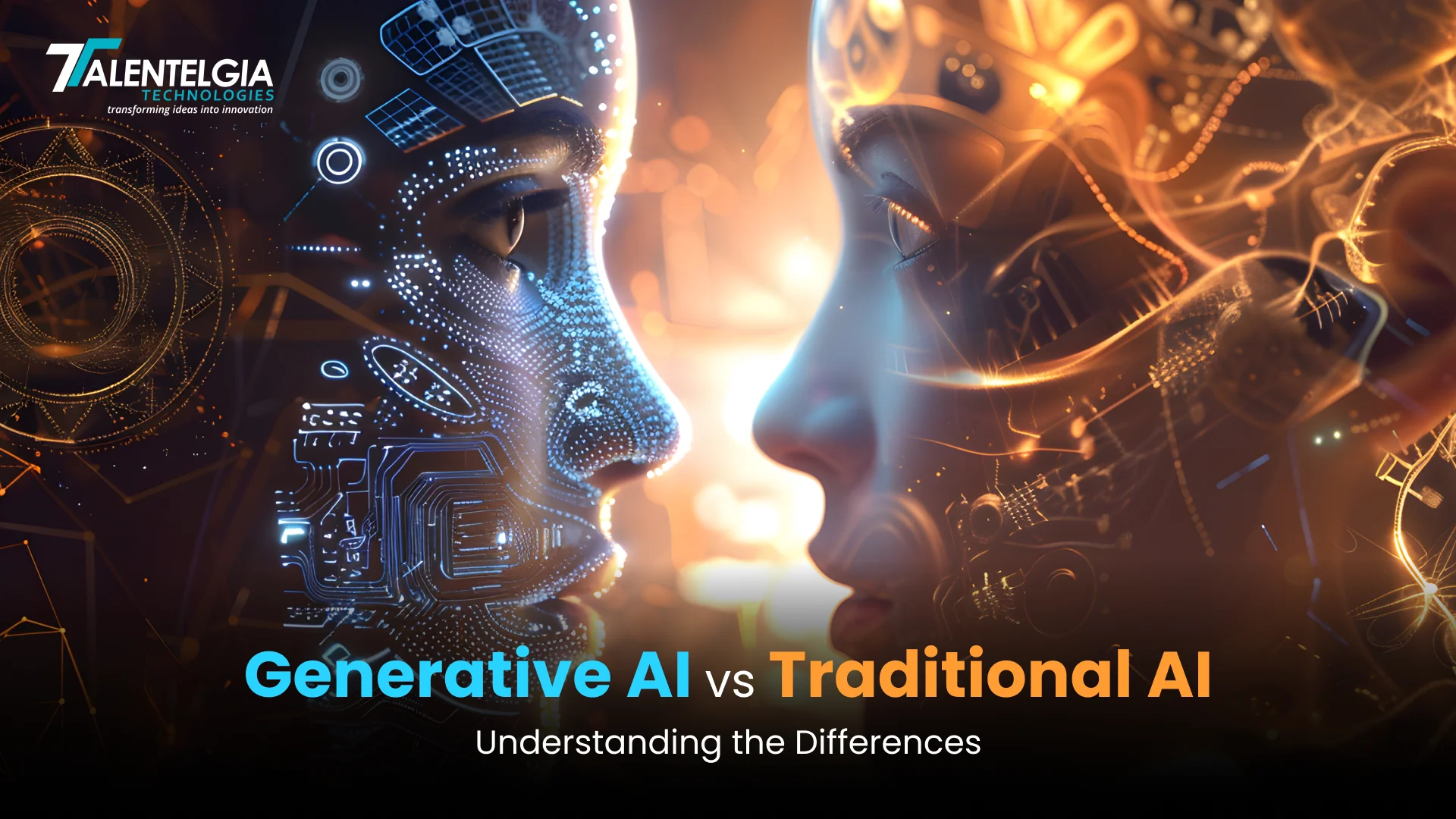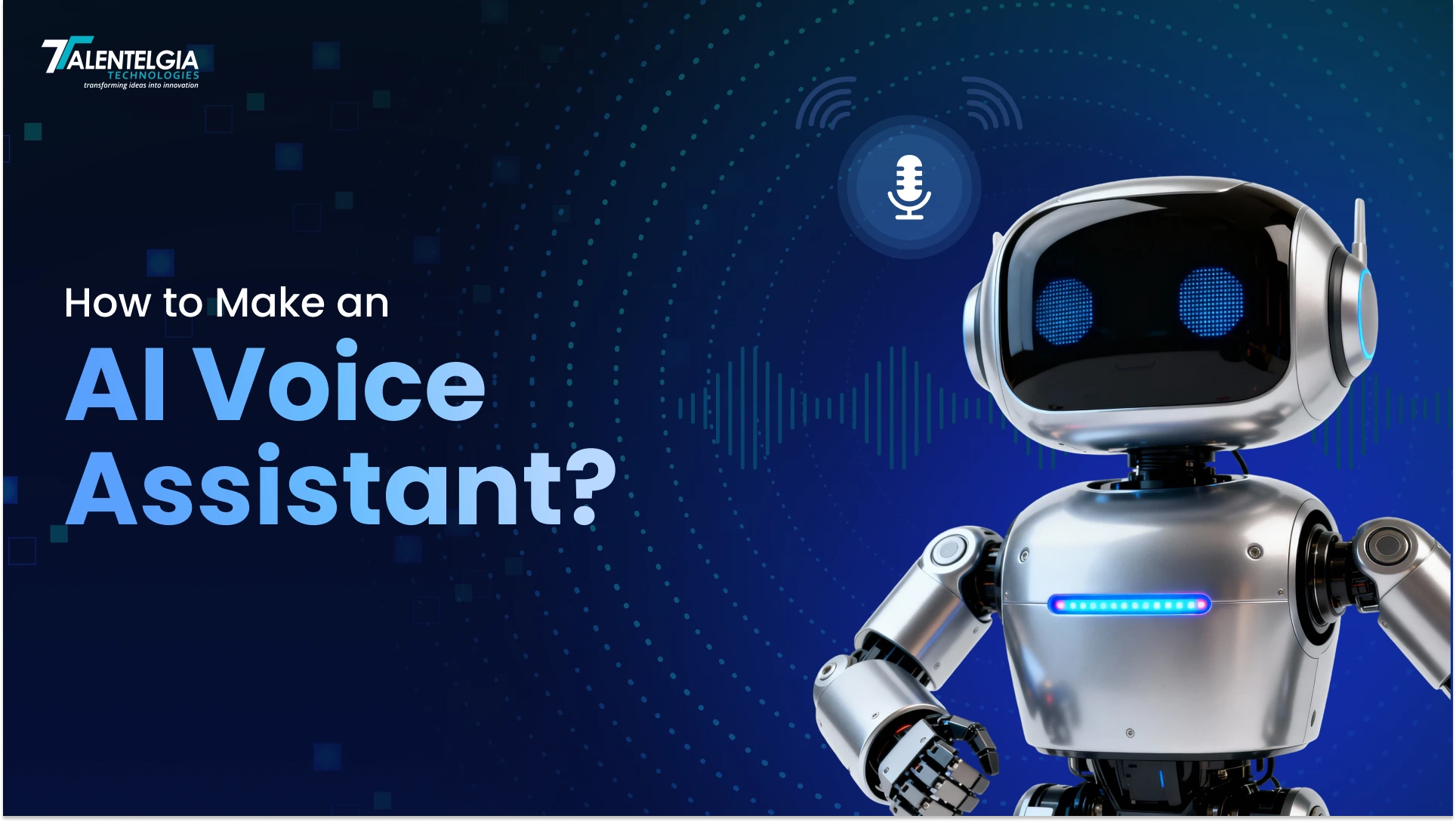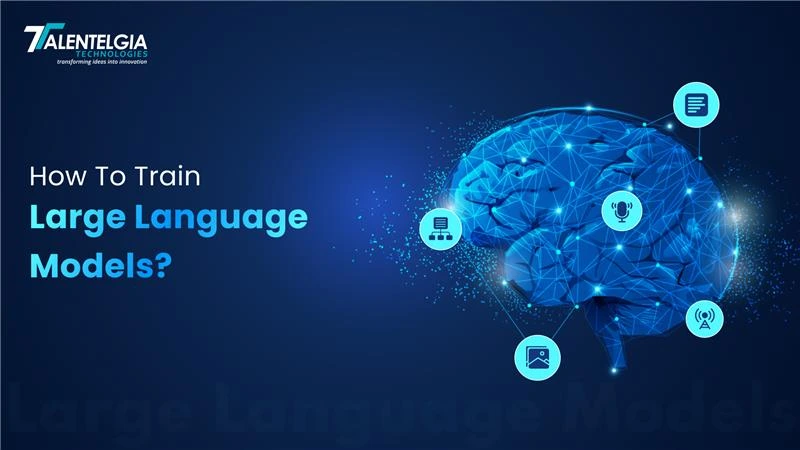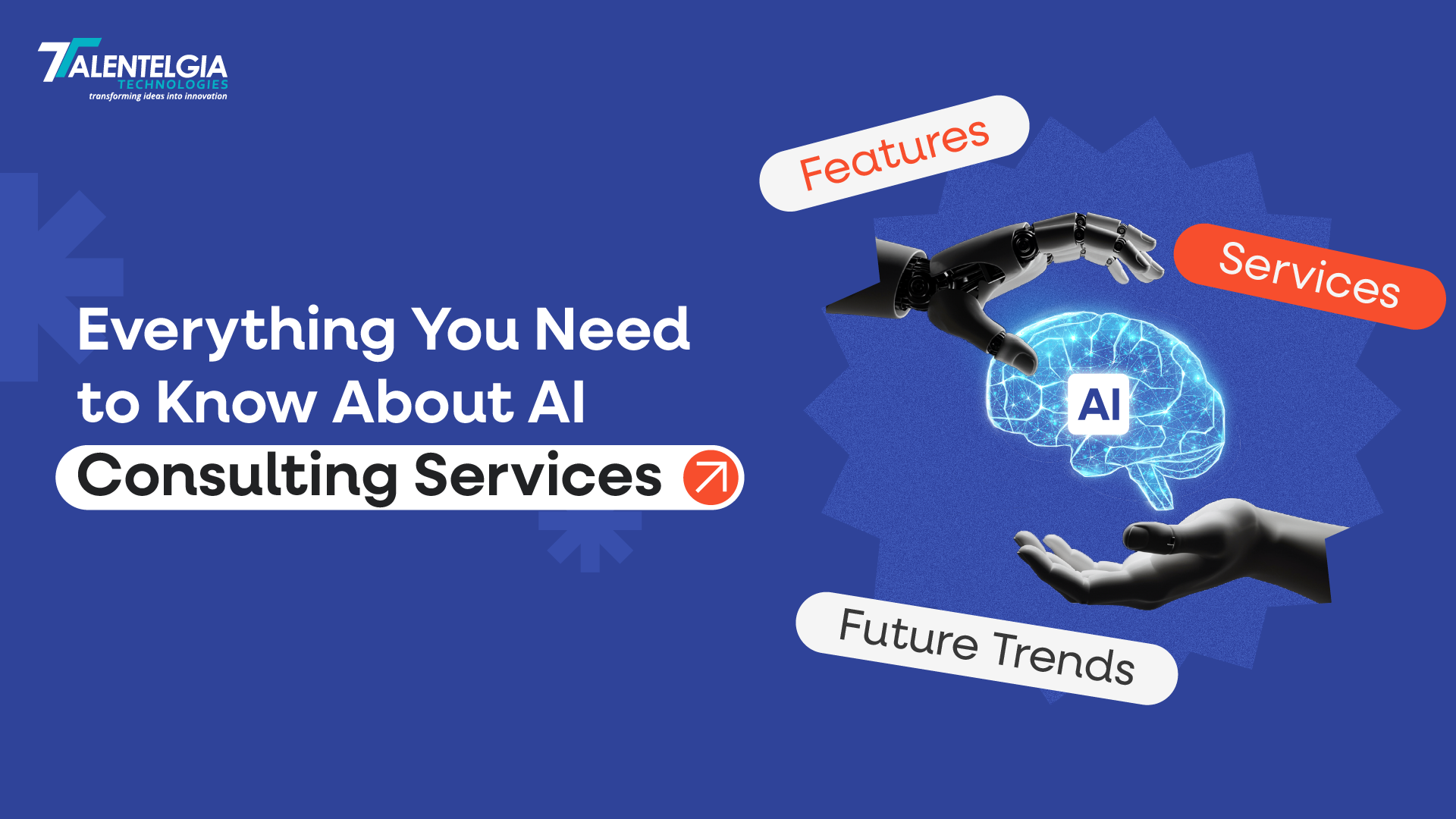Artificial Intelligence (AI) has been transforming industries and reshaping our daily lives for years. It encompasses two major types:
- Traditional AI and
- Generative AI
Each one of these has its own unique approach, technology, and applications.
While both are part of the broader AI landscape, they function on different principles and serve distinct purposes. Traditional AI focuses on data analysis, pattern recognition, and decision-making based on predefined rules. In short, Generative AI creates new data resembling human-created content, such as images, text, music, and videos.
This innovative technology is used in fields like creative arts, where it helps artists break new ground and explore fresh possibilities. It’s also being applied in drug discovery and personalized content creation.
However, Generative AI development also raises ethical questions around issues like privacy, authenticity, and the potential misuse of generated content.
In this blog, we’ll delve into the world of Generative AI vs Traditional AI, highlighting their characteristics, differences, and real-world applications.
What is Traditional AI (TA)?
Traditional AI is also called rule-based Artificial intelligence encompasses systems that rely on explicitly programmed rules and logic.
- This approach uses decades of AI research which focuses on problem-solving through predetermined algorithms and human-defined heuristics.
- Traditional AI (TA) emulates cognitive functions akin to those of the human mind, such as learning and problem-solving.
- It relies on rules designed by humans to analyze data, interpret inputs, and generate responses to achieve specific objectives.
Over the decades, Traditional AI has served as the cornerstone of AI research and applications which is leading to the development of numerous subfields that have made a significant impact on real-world problems and solutions.
Characteristics of Traditional AI
Below mentioned are some key characteristics that define traditional AI systems which helps in distinguishing them from more modern approaches:
- Systems based on Rule: Traditional AI uses a set of rules and logical steps manually created by experts to handle specific tasks and scenarios.
- Expert Systems: These are advanced AI systems designed to mimic the decision-making skills of a human expert in a specific domain. They rely on a knowledge base of facts and rules to solve problems.
- Narrow Focus: Traditional AI is often designed for specific tasks, such as playing chess, diagnosing diseases, or managing inventory.
- Limited Flexibility: Traditional AI requires manual updates to its rules and logic, making it less flexible and adaptable to new or unexpected situations.
Main Areas of Traditional AI
Traditional AI encompasses several key areas that have evolved over decades and contribute to different aspects of problem-solving and automation. The main areas of Traditional AI include:
- Machine Learning (ML): Focuses on creating models that learn patterns from data.
Example: Netflix and Amazon use ML to recommend shows or products based on users’ past behavior. - Deep Learning (DL): Uses complex, multi-layered neural networks to analyze data deeply, impacting areas like image and speech recognition.
Example: Self-driving cars use DL to recognize road signs and objects, while virtual assistants like Siri and Alexa use it to understand voice commands. - Natural Language Processing (NLP): Helps computers understand, interpret, and generate human language.
Example: Chatbots for customer service, Google Translate for language translation, and tools for analyzing social media sentiment to gauge public opinion. - Computer Vision: Allows machines to understand and interpret visual data.
Example: Facial recognition for security, medical imaging for detecting diseases, and drones in agriculture to monitor crop health.
Use Cases of Traditional AI
As traditional AI systems have demonstrated remarkable success in controlled environments and well-defined tasks. Their reliance on pre-coded rules limits and their ability to adapt as well as learn from new data or changing circumstances by providing innovative solutions across different domains. So, below are some of the most prominent use cases where traditional AI is making a serious impact:
1.Medical Diagnosis: Expert systems that suggest medical diagnoses based on symptoms and medical data. For Example:
- IBM Watson for Health: IBM Watson helps in diagnosing medical conditions by analyzing patient data and suggesting possible treatments.
- PathAI: PathAI uses AI to assist pathologists in diagnosing diseases from medical images.
2. Fraud detection Traditional AI can identify fraudulent activities and inconsistencies in transactions to help prevent fraud and ensure financial accuracy. For Example:
- SAS Fraud Management: SAS offers tools for detecting fraudulent activities and inconsistencies in transactions.
- FraudGuard: FraudGuard provides solutions for identifying and preventing financial fraud.
3. Customer Support: Automated systems that provide answers to common customer questions using predefined scripts. For Example:
- Zendesk: Zendesk offers automated customer support solutions using predefined scripts and responses.
- Freshdesk: Freshdesk provides automated customer support systems to handle common queries and issues.
4.Credit scoring Traditional AI can assess the creditworthiness of individuals and businesses using historical data to help financial institutions make lending decisions. For Example:
- FICO Credit Scoring: FICO provides tools for assessing creditworthiness based on historical data.
- Experian Credit Reports: Experian’s credit scoring services help evaluate credit risk for lending decisions.
5.Financial Services: Algorithmic trading systems that execute trades based on specific financial conditions and rules.For Example:
- MetaTrader: MetaTrader provides algorithmic trading systems that execute trades based on predefined financial conditions.
- TradeStation: TradeStation offers algorithmic trading platforms for executing trades based on set rules and conditions.
6. Compliance: Traditional AI can monitor transactions to ensure regulatory compliance. For Example
- ComplyAdvantage: ComplyAdvantage offers compliance monitoring tools to ensure regulatory adherence and detect financial crime.
7. Email spam filtering: Traditional AI can use predefined rules to identify and separate spam emails from legitimate ones. For Example:
- SpamAssassin: SpamAssassin is an open-source tool for filtering spam emails using predefined rules.
8. Recommendation systems: Traditional AI can suggest products or content to users based on their preferences and behavior. For Example:
- Amazon Personalize: Amazon Personalize provides personalized recommendations based on user behavior.
9. Virtual assistants: Traditional AI can understand and respond to user queries using predefined algorithms. For Example:
- Google Assistant: Google Assistant provides virtual assistant services using predefined algorithms.
- Amazon Alexa: Amazon Alexa is a virtual assistant that performs various tasks based on user commands.
10. Chess-playing programs: Traditional AI can create chess-playing algorithms that follow predetermined strategies to play against humans. For Example:
- Stockfish: Stockfish is an advanced chess engine that uses predetermined strategies to play chess.
11. Image classification: Traditional AI can be trained to identify good and defective products in real-time to help with defect detection and inspection in manufacturing. For Example:
- Amazon Rekognition: Amazon Rekognition offers image and video analysis for identifying objects and defects.
12. Predictive analytics: Traditional AI can analyze historical data and patterns to make predictions about future project outcomes.
13. Automation of repetitive tasks: Traditional AI can automate repetitive and time-consuming tasks. For Example:
- UiPath: UiPath offers robotic process automation (RPA) tools to automate repetitive business tasks.
- Automation Anywhere: Automation Anywhere provides RPA solutions for streamlining routine processes.
Traditional AI is good at tasks that require pattern recognition, logical reasoning, and decision-making based on predefined rules. However, it can be limited in its ability to adapt to dynamic environments and scale
Advantages and Disadvantages of Traditional AI
While Traditional AI has proven effective in many areas and it has also some limitations. So, Below are the advantages and disadvantages that will help to clarify where and how Traditional AI can be most effectively applied:
| Aspect | Advantages of Traditional AI | Disadvantages of Traditional AI |
| Task Performance | Traditional AI performs repetitive tasks quickly and accurately. | It is limited to specific tasks and cannot handle creative or novel problem-solving. |
| Data Handling | It can handle and analyze large amounts of data efficiently. | Traditional AI struggles to adapt to new situations or scenarios outside its training data. |
| Scalability | It easily scales to manage large-scale operations. | It lacks the ability to fully understand the complexities and nuances of human language. |
| Consistency | Traditional AI maintains a consistent level of performance for repetitive tasks. | It requires significant human intervention to update rules and adapt to new conditions. |
| Decision-Making | It has the ability to make decisions based on predefined rules and algorithms. | Traditional AI cannot learn autonomously from new data or experiences without manual updates to its algorithms. |
What is Generative AI?
Generative AI (Gen AI) focuses on understanding and processing data to create new content. This includes generating images, text, music, and videos. Unlike Traditional AI, which relies on fixed rules, Generative AI uses machine learning to find patterns in data and produce content that mimics human creativity.
While both Generative AI and Traditional AI use large datasets for training, Generative AI seeks to replicate the essence of human-created content rather than just following set rules.
Characteristics of Generative AI
Below mentioned are some key characteristics that define generative AI systems which helps in distinguishing them from more modern approaches:
- Data-Driven Learning: Generative AI models learn from vast amounts of data to understand patterns and relationships. They use this knowledge to generate new, original outputs, such as text, images, or music.
- Neural Networks: Deep learning techniques, including Generative Adversarial Networks (GANs) and Transformer models, are fundamental to generative AI. These networks can create highly realistic content based on their training data.
- High Adaptability: Generative AI can adapt to various tasks and domains without needing explicit programming for each scenario. It learns and generalizes from data, making it versatile.
- Creativity: Unlike traditional AI, which follows rigid rules, generative AI can produce creative and innovative outputs, such as generating realistic human faces, composing music, or writing coherent text.
Generative AI Models
Generative AI is a class of artificial intelligence that focuses on creating new data that is similar to a given dataset. There are several models that have been developed to enable generative AI and each with a unique approach and specialized capabilities. Here are some of the most prominent types of generative AI models:
- Generative Adversarial Networks (GANs):
- GANs are a popular type of Generative AI model where the data is being produced through the dual-network system.
- They use two networks working against each other: a “generator” and a “discriminator.”
- The generator creates new data, like images or sounds.
- The discriminator checks if the generated data is real or fake.
- This process helps GANs produce highly realistic outputs, such as lifelike images, natural-sounding speech, or smooth animations.
- Variational Autoencoders (VAEs): VAEs use an encoder-decoder framework to learn and generate new data.
- VAEs use an encoder-decoder approach to learn and create new data.
- The encoder compresses input data into a simplified form called a “latent space.”
- The decoder reconstructs the data from this latent space back to its original form.
- VAEs can generate new data points by sampling from this latent space.
- They are useful for tasks that require understanding data patterns, like improving image quality or generating new drug molecules.
Both models have the potential to generate synthetic data, create realistic multimedia, manipulate media, suggest product designs, and enhance security algorithms.
Use Cases of Generative AI
As generative AI is transforming the way we create, interact and consume content by providing innovative solutions across different domains. Let’s understand some of the most prominent use cases where generative AI is making a serious impact:
- Image Generation:Generative AI models can create images that look like real photographs or artwork. Examples include:
- Dall-E: Generates diverse and creative images from textual descriptions.
- Storia Lab: Creates unique visual content based on user inputs.
- Stylar: Offers tools for generating and editing images with artistic styles.
- Text Generation: These models can produce written content that mimics human language by understanding context and language patterns. Applications include:
- Presentation Generators: Tools that create slides and presentations based on text inputs. For Example: Gamma App
- AI Assistants: Systems that can draft emails, articles, or other written materials. For Example:
Claude, Synthesia, Rely.io
- Music Composition: Specialized models can compose original music by analyzing patterns and styles.
- Video Generations: Generative AI can generate videos, and blend and modify video footage to create entirely new videos. For Example: Pictory , Visla , PlayPhrase.me – Finds the related movie clips for phrases
- Drug Discovery: By analyzing chemical compounds and their properties, Generative AI can aid in identifying potential new drugs for research and AI development services.
- Fake Check: Generative AI also plays a role in verifying the authenticity of content, such as detecting deepfakes or misleading information.
Advantages and Disadvantages of Generative AI
Explore the advantages and disadvantages of generative AI. It plays an important role in maximizing its potential while mitigating the downsides and a balanced perspective helps in making informed decisions about where and how to implement generative AI solutions effectively, efficiently and ethically. Here are the key advantages and disadvantages of generative AI:
| Aspect | Advantages of Generative AI | Disadvantages of Generative AI |
| Content Creation | It is useful in framing content for marketing, design, and entertainment. | It lacks originality and may produce content that is similar to existing works. |
| Speed | Generative AI is faster than Traditional AI and humans in generating new content. | The effectiveness and accuracy of Generative AI depend heavily on the quality and quantity of the training data used. |
| Personalization | It personalized content at scale, allowing for tailored experiences based on user data. | It may result in unfair outputs and inherent biases from the training data, affecting fairness and inclusivity. |
| Human-like Interactions | Generative AI replicates human-like interactions in a natural way, enhancing user engagement and communication. | It is useful in creating deepfakes and deceptive content, which can be used maliciously. |
| Flexibility | It can adapt to a wide range of tasks and generate diverse outputs across different domains. | It may struggle with producing content that fully aligns with human creativity and complex contextual understanding. |
Generative AI vs. Traditional AI: Key Differences
Generative AI and Traditional AI represent two different fundamental approaches to artificial intelligence and each comes with its own methodologies, applications, and limitations. Key differences based on their aspects between Generative AI vs Traditional AI:
| Aspect | Traditional AI | Generative AI |
| Learning Method | Traditional AI relies on human-defined rules and fixed algorithms. | Generative AI uses machine learning to find patterns in data and improve over time. |
| Flexibility | It is inflexible and performs well only within specific and defined tasks. | It is flexible and can be applied to a wide range of tasks and situations. |
| Decision-Making | It makes decisions based on logical rules and past data. | It learns from experience and generates unique and optimal solutions. |
| Human Involvement | Traditional AI requires significant human intervention to create and update rules. | Generative AI requires less human input once trained, as it can learn autonomously. |
| Problem-Solving | Solves problems using direct instructions provided by humans. | Generative AI solves problems by identifying patterns and learning from examples. |
| Output Types | It produces specific, predictable outputs based on rules. | Generative AI generates diverse and unexpected outputs, such as text, images, or music. |
| Applications | It is best suited for structured tasks like data entry, inventory management, etc. | It is suitable for creative tasks like content creation, design, and art. |
| Processing Ability | It is limited to processing structured, rule-based data. | It is capable of handling unstructured data like images, audio, and text. |
| Error Handling | The errors occur if rules are incorrect and difficult to adapt to new errors. | It can learn from mistakes and improve performance over time. |
| Complexity | It is less complex as it relies on direct rules and logic. | It is more complex, as it involves learning from vast amounts of data. |
| Performance | I has consistent performance in specific, well-defined areas. | Its performance improves with more data and continued learning. |
| Scalability | Limited scalability and adding new capabilities require manual adjustments. | Highly scalable and can adapt and expand with more data and computational power. |
Real-world Examples of both Traditional AI and Generative AI to demonstrate their differences
Traditional AI Examples
To better understand the Traditional AI, it will be helpful to explore its real-world field of implementations. Below are the examples that demonstrate how Traditional AI is applied in various industries and scenarios:
| Aspect | Example | Description |
| Spam Filters in Email | Gmail or Outlook | It uses predefined rules to classify emails as “spam” or “not spam.” |
| Navigation Systems | Garmin GPS or early versions of Google Maps | It follows fixed algorithms to calculate the best routes based on traffic data and user input. |
| Chess Programs | IBM’s Deep Blue | Utilizes a set of rules and strategies to determine the best possible move in a chess game. |
| Automated Customer Service | Basic chatbots or Interactive Voice Response (IVR) systems | Uses fixed scripts to answer frequently asked questions or route calls based on specific keywords. |
| Medical Diagnosis | Expert systems | Provides diagnostic suggestions based on predefined rules and medical knowledge. |
| Stock Market Trading | Algorithmic trading systems | Executes trades using predefined financial rules and market conditions. |
Generative AI Examples
Lets have a look at how Generative AI is used in real-world situations. Here are some examples showing its use in various scenarios:
| Aspect | Example | Description |
| Text Generation | ChatGPT | Generates human-like text, answers questions, or creates stories based on user prompts. |
| Image Creation | DALL-E, Midjourney | Creates new images from text descriptions, like “a cat riding a bicycle under a rainbow.” |
| Music Composition | AIVA | Composes original music pieces in various styles by learning from existing music datasets. |
| Video Content Creation | Synthesia | Creates videos with synthetic avatars speaking multiple languages, used in content creation and marketing. |
| Voice Assistants | Siri, Google Assistant, Alexa | Understands natural language and learns from user interactions to perform tasks or provide personalized responses. |
| Deepfake Technology | Deepfake videos and audio tools | Generates realistic fake videos or audio for both creative and potentially harmful uses, like misinformation. |
These differences highlight that Traditional AI is effective for well-defined and repetitive tasks. Generative AI is more versatile, creative and adaptable which makes it suitable for a wider range of applications including those requiring innovation and complex problem-solving.
Ethical Considerations When Using Generative AI
When using Generative AI, it’s important to think carefully about several ethical issues to ensure the technology is used responsibly and fairly. Here are some key areas to consider:
1. Accuracy and Trust
Generative AI relies on data to learn and make decisions. If the data it is trained on is biased or inaccurate, the AI can produce flawed or unfair results, reinforcing negative stereotypes or biases. For example, biased AI could result in discriminatory hiring practices or skewed financial decisions. To prevent this, it’s crucial to use accurate, unbiased data that represents diverse populations and to implement methods to validate data and reduce bias.
2. Risk Management
Generative AI can unintentionally create harmful content, such as generating fake legal documents, producing inaccurate financial reports, or creating biased images. These errors could lead to serious consequences, including lawsuits or damage to an organization’s reputation. To mitigate risks, it is essential to review AI-generated content carefully, establish safeguards, and define accountability for any negative outcomes.
3. Data Privacy
Using personal or sensitive data to train Generative AI models can lead to privacy and security issues. Organizations should have strong data governance policies to protect data and comply with regulations like the General Data Protection Regulation (GDPR) and the California Consumer Privacy Act (CCPA).
4. Legal and Copyright Issues
Generative AI can create new content, raising questions about who owns that content and whether it infringes on existing copyrights. For example, recent legal cases like Andersen v. Stability AI et al. highlight the challenges around copyright and data misuse. Organizations need to navigate these issues carefully to avoid plagiarism and infringement.
5. Transparency
Being transparent about how Generative AI makes decisions is critical to building trust with users and stakeholders. Clearly explaining the AI’s processes, potential biases, and limitations helps ensure confidence in its outputs and promotes ethical use.
6. Regulatory Compliance
Governments worldwide are developing laws to regulate the use of AI, including Generative AI. Organizations must comply with these regulations to ensure ethical practices, avoid legal trouble, and maintain trust and transparency.
7. Bias
Generative AI can exhibit biases that go beyond the data it was trained on, which is particularly problematic in areas like recruitment and loan approvals. Organizations must actively work to identify and mitigate these biases to ensure fair and unbiased outcomes.
8. Deepfake Concerns
Advancements in Generative AI have made it easier to create deepfakes—realistic but false images, videos, or audio recordings that can mislead or manipulate people. These deepfakes can have serious consequences, such as spreading misinformation or damaging reputations. Governments and tech companies are developing tools to detect and prevent deepfakes, but creators also have a duty to ensure their content is authentic.
9. Job Displacement
As Generative AI becomes more advanced, it could lead to job losses in certain sectors due to increased automation. Organizations should consider retraining or reskilling programs for employees whose roles may be at risk.
10. Market Impact
According to a report by TechSci Research, the global Artificial Intelligence market was valued at USD 128.89 billion in 2022 and is expected to grow significantly, with a projected growth rate of 40.71% from 2023 to 2028. This growth is driven by advances in machine learning, deep learning, and increased data availability, which means AI, including Generative AI, will continue to evolve rapidly.
Also Read: How To Create an AI Assistant
Conclusion
Generative AI and Traditional AI are two different methods of artificial intelligence and each have its own benefits and drawbacks. Generative AI uses data to learn, adapt and create new content which makes it highly creative and flexible. On the other hand, Traditional AI works best in areas with clear rules and specific tasks providing dependable and understandable outcomes.
So when we have to choose between Generative AI and Traditional AI it depends on your requirements. We often mix them and both can be the most effective way to tackle complex challenges and take advantage of the strengths each offers.
As AI technology develops, both Generative and Traditional AI will likely work together to drive progress and innovation. If you want to know which approach is best for your organization, consider speaking directly with one of our experts for personalized advice.


 Healthcare App Development Services
Healthcare App Development Services
 Real Estate Web Development Services
Real Estate Web Development Services
 E-Commerce App Development Services
E-Commerce App Development Services E-Commerce Web Development Services
E-Commerce Web Development Services Blockchain E-commerce Development Company
Blockchain E-commerce Development Company
 Fintech App Development Services
Fintech App Development Services Fintech Web Development
Fintech Web Development Blockchain Fintech Development Company
Blockchain Fintech Development Company
 E-Learning App Development Services
E-Learning App Development Services
 Restaurant App Development Company
Restaurant App Development Company
 Mobile Game Development Company
Mobile Game Development Company
 Travel App Development Company
Travel App Development Company
 Automotive Web Design
Automotive Web Design
 AI Traffic Management System
AI Traffic Management System
 AI Inventory Management Software
AI Inventory Management Software
 AI Software Development
AI Software Development  AI Development Company
AI Development Company  AI App Development Services
AI App Development Services  ChatGPT integration services
ChatGPT integration services  AI Integration Services
AI Integration Services  Generative AI Development Services
Generative AI Development Services  Natural Language Processing Company
Natural Language Processing Company Machine Learning Development
Machine Learning Development  Machine learning consulting services
Machine learning consulting services  Blockchain Development
Blockchain Development  Blockchain Software Development
Blockchain Software Development  Smart Contract Development Company
Smart Contract Development Company  NFT Marketplace Development Services
NFT Marketplace Development Services  Asset Tokenization Company
Asset Tokenization Company DeFi Wallet Development Company
DeFi Wallet Development Company Mobile App Development
Mobile App Development  IOS App Development
IOS App Development  Android App Development
Android App Development  Cross-Platform App Development
Cross-Platform App Development  Augmented Reality (AR) App Development
Augmented Reality (AR) App Development  Virtual Reality (VR) App Development
Virtual Reality (VR) App Development  Web App Development
Web App Development  SaaS App Development
SaaS App Development Flutter
Flutter  React Native
React Native  Swift (IOS)
Swift (IOS)  Kotlin (Android)
Kotlin (Android)  Mean Stack Development
Mean Stack Development  AngularJS Development
AngularJS Development  MongoDB Development
MongoDB Development  Nodejs Development
Nodejs Development  Database Development
Database Development Ruby on Rails Development
Ruby on Rails Development Expressjs Development
Expressjs Development  Full Stack Development
Full Stack Development  Web Development Services
Web Development Services  Laravel Development
Laravel Development  LAMP Development
LAMP Development  Custom PHP Development
Custom PHP Development  .Net Development
.Net Development  User Experience Design Services
User Experience Design Services  User Interface Design Services
User Interface Design Services  Automated Testing
Automated Testing  Manual Testing
Manual Testing  Digital Marketing Services
Digital Marketing Services 
 Ride-Sharing And Taxi Services
Ride-Sharing And Taxi Services Food Delivery Services
Food Delivery Services Grocery Delivery Services
Grocery Delivery Services Transportation And Logistics
Transportation And Logistics Car Wash App
Car Wash App Home Services App
Home Services App ERP Development Services
ERP Development Services CMS Development Services
CMS Development Services LMS Development
LMS Development CRM Development
CRM Development DevOps Development Services
DevOps Development Services AI Business Solutions
AI Business Solutions AI Cloud Solutions
AI Cloud Solutions AI Chatbot Development
AI Chatbot Development API Development
API Development Blockchain Product Development
Blockchain Product Development Cryptocurrency Wallet Development
Cryptocurrency Wallet Development About Talentelgia
About Talentelgia  Our Team
Our Team  Our Culture
Our Culture 
 Healthcare App Development Services
Healthcare App Development Services Real Estate Web Development Services
Real Estate Web Development Services E-Commerce App Development Services
E-Commerce App Development Services E-Commerce Web Development Services
E-Commerce Web Development Services Blockchain E-commerce
Development Company
Blockchain E-commerce
Development Company Fintech App Development Services
Fintech App Development Services Finance Web Development
Finance Web Development Blockchain Fintech
Development Company
Blockchain Fintech
Development Company E-Learning App Development Services
E-Learning App Development Services Restaurant App Development Company
Restaurant App Development Company Mobile Game Development Company
Mobile Game Development Company Travel App Development Company
Travel App Development Company Automotive Web Design
Automotive Web Design AI Traffic Management System
AI Traffic Management System AI Inventory Management Software
AI Inventory Management Software AI Software Development
AI Software Development AI Development Company
AI Development Company ChatGPT integration services
ChatGPT integration services AI Integration Services
AI Integration Services Machine Learning Development
Machine Learning Development Machine learning consulting services
Machine learning consulting services Blockchain Development
Blockchain Development Blockchain Software Development
Blockchain Software Development Smart contract development company
Smart contract development company NFT marketplace development services
NFT marketplace development services IOS App Development
IOS App Development Android App Development
Android App Development Cross-Platform App Development
Cross-Platform App Development Augmented Reality (AR) App
Development
Augmented Reality (AR) App
Development Virtual Reality (VR) App Development
Virtual Reality (VR) App Development Web App Development
Web App Development Flutter
Flutter React
Native
React
Native Swift
(IOS)
Swift
(IOS) Kotlin (Android)
Kotlin (Android) MEAN Stack Development
MEAN Stack Development AngularJS Development
AngularJS Development MongoDB Development
MongoDB Development Nodejs Development
Nodejs Development Database development services
Database development services Ruby on Rails Development services
Ruby on Rails Development services Expressjs Development
Expressjs Development Full Stack Development
Full Stack Development Web Development Services
Web Development Services Laravel Development
Laravel Development LAMP
Development
LAMP
Development Custom PHP Development
Custom PHP Development User Experience Design Services
User Experience Design Services User Interface Design Services
User Interface Design Services Automated Testing
Automated Testing Manual
Testing
Manual
Testing About Talentelgia
About Talentelgia Our Team
Our Team Our Culture
Our Culture

















 Write us on:
Write us on:  Business queries:
Business queries:  HR:
HR: 




